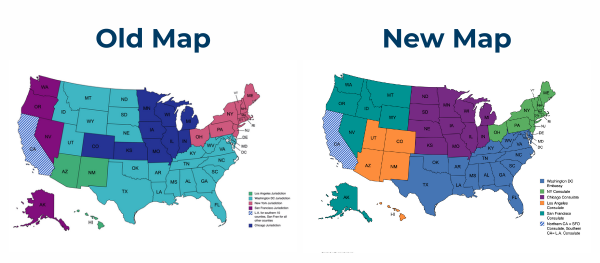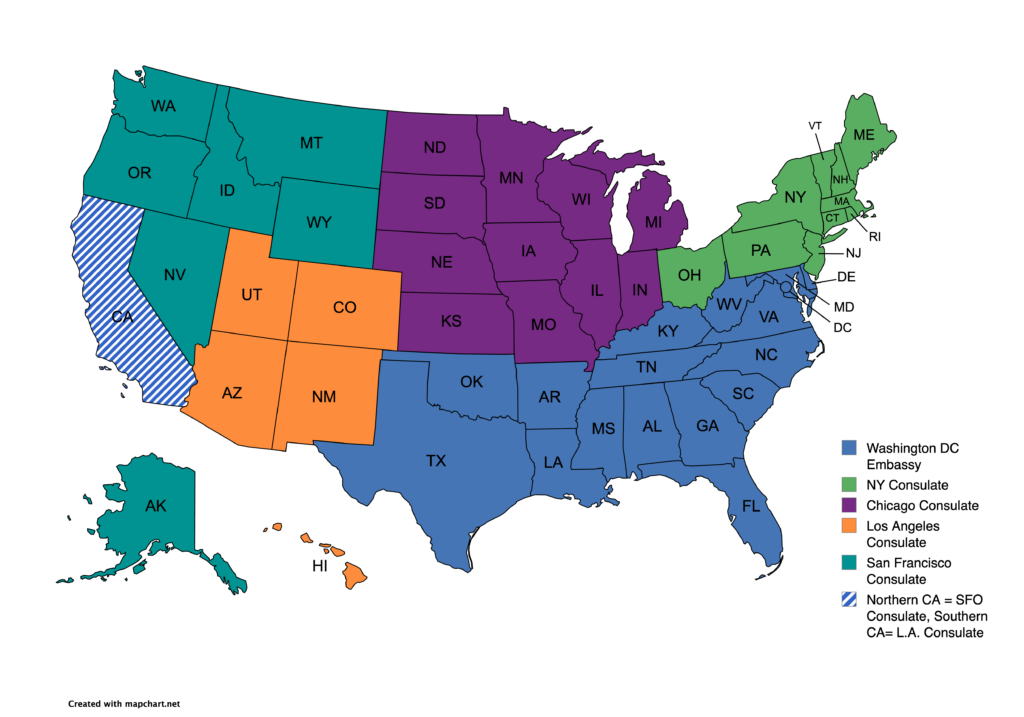An important part of applying for a China visa is knowing and understanding which jurisdiction you reside in. Not only can this information help you get your visa quickly, but it ensures that you aren’t applying at the wrong consulate. It’s important to stay up-to-date with all of the current news regarding China consulate jurisdictions, as they can change from time to time. In fact, there are some recent changes to the jurisdictions that you should be aware of, especially if you plan on applying for a China visa in the near future.
So, what changes were put into place and how could this affect how you obtain a visa to China? Here’s everything we think you should know.
What Changes Were Made to the China Consulate Jurisdictions?

On June 29th, 2024, the Embassy of the People’s Republic of China in the United States of America announced that they adjusted the China consulate jurisdictions across the United States. This changed how the map of China consulate jurisdictions looks, and, ultimately, where people will need to apply for their Chinese visas. So, if you’ve applied for a China visa in the past, these changes could affect where you will need to apply for a Chinese visa going forward.
The maps above show the changes that were made. There were many adjustments, and the new map looks significantly different. Depending on where you live, you may now have to apply at a different Chinese consulate than what you’re used to. Here are some of the notable changes for each China consulate and embassy in the United States:
Chicago Consulate
The Chicago consulate jurisdiction gained a few states but also lost some states, too. The states that are now part of the Chicago consulate jurisdiction include North Dakota, South Dakota, and Nebraska. Colorado used to be part of the Chicago jurisdiction but is no longer included. Colorado is now part of the Los Angeles consulate jurisdiction.
Washington DC Embassy
The China Embassy in Washington DC lost 7 states, and didn’t gain any states in the process. The states that are no longer part of the China Embassy in Washington DC include Utah, Idaho, Montana, Wyoming, North Dakota, South Dakota, and Nebraska.
New York Consulate
Many changes were made to the new Chinese jurisdiction map. But one thing that didn’t change was the number of states that are part of the New York consulate jurisdiction. In fact, the New York consulate has made no changes.
Los Angeles Consulate
The Los Angeles consulate jurisdiction had some changes, including adding some states. Previously, only Arizona, New Mexico, Hawaii, and the southern 10 counties in California were part of this jurisdiction. But with the new China jurisdiction map, Utah and Colorado are now part of the Los Angeles consulate jurisdiction, too.
San Francisco Consulate
Previously, the San Francisco consulate jurisdiction only included Washington, Oregon, Nevada, Alaska, and the northern counties of California. With the new Chinese jurisdiction map, Idaho, Montana, and Wyoming were added to the San Francisco consulate jurisdiction.
When Did These Changes Go Into Effect?
The new Chinese consulate jurisdiction map was officially put into place on June 29th, 2024. The old Chinese consulate jurisdiction map was in place for quite some time, but it didn’t come as a shock that new changes were put into effect. The map can change from time to time, and the United States of America and the People’s Republic of China were in talks for some time before finally agreeing on the new map.
How Do I Know What Jurisdiction I Reside in?

New China consulate jurisdiction map, effective June 29th, 2024.
Many changes were made to the China consulate jurisdiction map, and it’s important to study the changes that have been put into place so that you know which jurisdiction you reside in. Simply find the state that you live in, and then use the key to match up the colors and see what China consulate you need to apply at.
Though most of the map is easy to understand, one part that may confuse some people is what consulate they should apply at if they live in California. Depending on what part of California you live in, you’ll need to apply at a different consulate. For example if you live in Northern California, you’ll need to apply at the San Francisco consulate. But if you live in Southern California, you’ll need to apply for a China visa at the Los Angeles consulate.
Do I Need a Visa to Visit China?
If you are a United States citizen and plan on traveling to China, you will need to obtain a passport and most likely a Chinese visa, too. There are many different types of China visas, and it’s essential that you know what type of visa you need to apply for, so that you can obtain the correct one. Below is a list of some of the Chinese visas that people frequently apply for:
- China Tourist Visa
- China Business Visa
- China Private Visa
- China Crew Visa
- China Student Visa
- China Work Visa
Learn more about the different types of China visas, and decide which is best for you by going to our website.
How Can I Apply For a China Visa?
If you plan on traveling to China and need to get a China visa, we can help! Obtaining a visa with Swift is a quick and easy process. To begin your application, visit our website. Once you have submitted all of the required information and sent in all of the necessary documents, we will review your application, and help correct any errors that may arise. Then, once your Chinese visa has been processed, we will send it to you, so that you have it in time for your trip.
What questions do you have about the China consulate jurisdiction changes? Let us know in the comments below!

